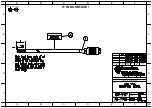
User Manual: Generic Section
Section: 13 Acoustic Navigation Principles
Revision: 00
Page
6of 9
1.3
ULTRA SHORT BASE LINE PRINCIPLES (REF. FIG 3)
USBL transducers are all built into a single transceiver assembly - or the array of transducers is replaced by
an array of transducer elements in a single transceiver assembly.
The distances or ranges are measured as they are in an SBL system but the time differences are now much
less. Systems using sinusoidal signals measure the "time-phase" of the signal in each element with respect
to a reference in the receiver. The "time-phase differences" between transducer elements are computed by
subtraction and then the system is equivalent to an SBL system.
Similar rules apply in that systems using three elements (or groups of elements) have the same restrictions
as SBL systems with three transducers. USBL systems using four elements have the same restrictions as
SBL systems using four transducers and so on.
Another restriction is that if an unambiguous position within a hemisphere is required and there are only
three elements or element groups in use, then the element spacing must be less than one-half wavelength of
the signal. Alternatively, a prior set of measurements must have been made with an element spacing of less
than one-half wavelength.
Another difference is that the transducer elements are in a transceiver assembly that is placed somewhere in
the vessel frame. The attitude of the assembly in the vessel frame must be measured during installation. A
USBL system positions a transponder in a frame fixed to the transceiver assembly, not directly in a vessel-
fixed frame as in the SBL case.
Summary of Contents for 8142-000-01
Page 100: ......
















































